Poison ivy (Toxicodendron radicans) is a very common plant in the United States and it is very persistent. Poison ivy grows rampant and can quickly take over an area.
One common sign that you’ve had contact with poison ivy is an itchy rash on the skin where the contact happened. It may be just red and itchy, but the rash usually forms fluid-filled blisters before long. If you scratch, this rash can quickly spread to other areas of the body or to family and friends. And believe me, that is not a good thing.Not everyone reacts to poison ivy, so if you don’t get a rash it may mean that you are immune. Investigate the suspicious plant carefully, because your family members may react badly. In this article, I will teach you how to identify poison ivy in your backyard or neighborhoods, and how to get rid of it.
Growth Habit Of Poison Ivy
The plant is most known for the pattern of three leaves in each set. But where it grows in a mass, many leaves bunch together and you may not notice that the leaves are in sets of three, so look closely and don’t touch.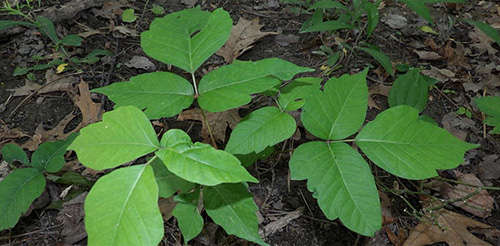 Poison ivy is not a real ivy, but its growth pattern is similar. It grows up surfaces like walls, fences, over trees or bushes, between rocks, and along the ground. However, it can also grow in a bush pattern or form a dense mass of growth. I have even seen the vines wrap around each other and take on the shape of a tree.
Poison ivy is not a real ivy, but its growth pattern is similar. It grows up surfaces like walls, fences, over trees or bushes, between rocks, and along the ground. However, it can also grow in a bush pattern or form a dense mass of growth. I have even seen the vines wrap around each other and take on the shape of a tree.
Related: 26 Ancient Remedies That We Lost to History
The Leaves Of Poison Ivy
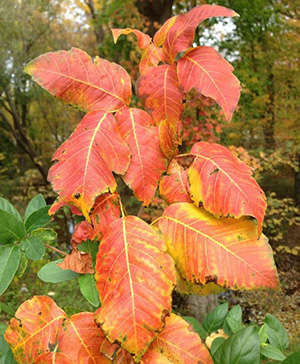
As mentioned above, poison Ivy leaves always grow in sets of three. However, some other plants also grow in clusters of three. When you see a set of three leaves, be careful. Look for the other identifying characteristics without touching the plant.
Poison ivy plants are usually bright green in the summer and turn yellow to red in the autumn. You will often see young, smaller red leaves alongside the green leaves. In autumn, leaves may be anywhere from deep red to orange or yellow and can even be mottled with both colors. Leaves sporting yellow or orange may also be poison oak.
Poison ivy leaves in my area are usually smooth and lance-shaped, but some varieties are serrated or even lobed on the sides. All varieties come to a point at the leaf tip.
Each group of three leaves has a center leaf that is longer than the two side leaves and has a stem. The side leaves grow directly from the vine. Unfortunately, you may not notice the difference if you are not looking closely. The difference is small, but it is there.
Often the leaves will appear darker and waxy or shiny; but this is not always true. The undersides are lighter in color and fuzzy. Don’t be tempted to touch it, however. If you must, wear gloves.
The Vine And Poison Ivy Flowers
The vine or bush will usually produce clusters of small flowers in the spring. The flowers are often white but can also be yellowish white and may have yellow centers.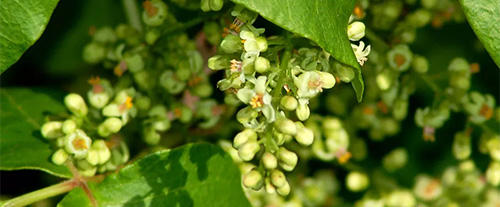 When the flowers fade, small clusters of white, greenish-white or tan berries appear and stay on the vine throughout the winter. Birds eat these berries, but you should never be tempted – notice the word “poison” in their name?
When the flowers fade, small clusters of white, greenish-white or tan berries appear and stay on the vine throughout the winter. Birds eat these berries, but you should never be tempted – notice the word “poison” in their name?
Teach Grandchildren To Avoid Poison Ivy
Teachers and parents have come up with rhymes to teach children to identify and avoid poison ivy. The one I learned as a child was “Leaves of three, let them be!” which also worked for poison oak. Here are some others:
- Count the leaves, 1, 2, 3? Don’t touch me!
- Berries white, danger in sight.
- Berries white, run in fright.
- Longer middle stem? Stay away from them.
- Red leaves in the spring is a dangerous thing.
- Side leaves like mittens, itches like the dickens.
How To Get Rid Of Poison Ivy In Your Backyard
Stop! Read all these instructions before you even think about getting rid of poison ivy. My father-in-law was one of the lucky people who is immune to poison ivy. However, when he started removing it from his backyard, he decided to burn the vines to make sure the plants were completely gone. This is a very bad decision, even if you are immune. He found that he was not immune to the smoke and got one of the worst cases of poison ivy ever. The smoke can also damage your lungs – imagine that rash! So, no burning! Likewise, no composting. You don’t need a new generation of poison ivy in your compost, or spreading throughout your garden.
Related: 21 Wild Edibles You Can Find in Urban Areas
Dress For The Job
You need protective clothing, no matter which method you choose. Wear shoes, socks, long pants, long sleeve shirt, and gloves. If possible, choose clothing which is not absorbent such as a windbreaker, hip waders, or other waterproof clothing. The oils from the plant can soak through regular clothing when you are working with a lot of plants. And be very careful, when removing your clothes, not to touch your skin.
Apply Herbicides On Poison Ivy
This is probably the easiest way to get rid of poison ivy, but my least favorite. I just don’t like spraying areas where my children play. Herbicides that contain glyphosate, triclopyr, amitrole or 2, 4-D will do the job. Just make sure to avoid other plants and to continue spraying the poison ivy plants until they are dead, it will take multiple sprays. Once you’ve killed them, dig the plants up, roots and all, and put them in a plastic lawn bag. Check the area closely the next spring to make sure no new sprouts appear.
My Favorite Method
I recommend this method because it is only a little more work than the herbicide method and it works without adding dangerous chemicals to the environment.
This Is A Four-Step Method:
#1. Wearing protective clothing, cut off the vines at the ground level with gardening shears. Scrub the shears with soapy water to remove all the oils after use. Put the vines in a plastic lawn bag for disposal.
#2. Choose a day when the soil is damp or wet. This makes it easier to dig and to get the smaller side roots without breaking them. Wearing gloves, dig up the entire root system, using the tip of the shovel to remove small bits that may come loose. Dispose of the roots in a plastic lawn bag.
#3. This step is optional, or you could skip step 2 and just do this one. But I like to do both steps to make sure I get as much of the roots as possible. For this step, pour boiling water in the hole and stretching out around the removed roots. This will kill any roots remaining in the soil. Repeat this step several days in a row and watch for sprouts returning.
#4. Early the following spring, begin watching for sprouts that might have survived and treat them as well. Poison ivy is hard to kill completely; it seems to always return. So, you must be vigilant.
I cannot over-emphasize how important it is to be watchful for poison ivy on your land. It can cause a lot of suffering if ignored. The best results are achieved if you eradicate it as soon as possible and watch the area like a hawk for returning sprouts.
I hope this helps you identify and remove any poison ivy in your yard. This is one plant you shouldn’t ignore.
You may also like:
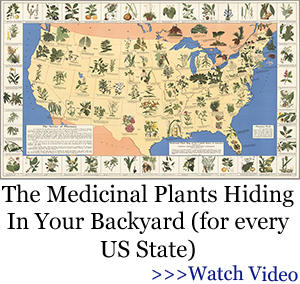 16 Wild Edibles You Didn’t Know You Could Forage For
16 Wild Edibles You Didn’t Know You Could Forage For
This Bug Will Kill Most Americans During The Next Crisis (Video)
This Common Household Item Is One Of The Most Useful Survival Assets

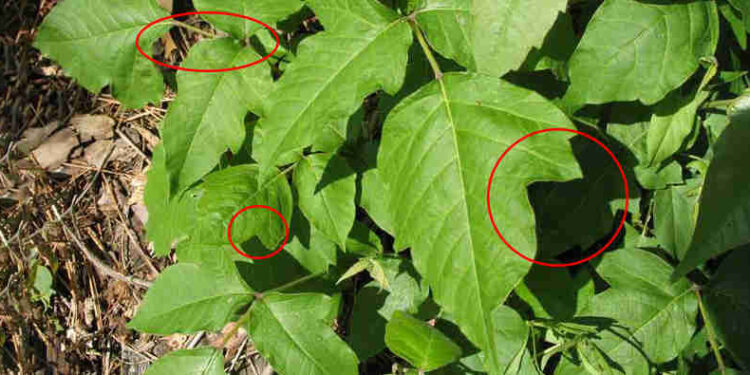













For anyone wishing to practice, and get proficient at removing poison ivy, contact me. I have plenty.
BTW.. I am not Tom Sawyer, so you won’t even have to pay me.
All good practices here. What I did was found the base of the root system and used my cordless drill to drill into the center of the vine. I then filled a plant watering bulb with bleach and stuck it in the hole. Haven’t seen poison ivy in that area of my yard for 7 yrs so far.
As mentioned before, carefully remove all your clothing after handling poison ivy. My husband is immune to the ivy, but takes care to put all affect clothes, undies and sox too, into a plastic trash bag until he can put them into the washing machine himself. Use a full tub of hot water and a good detergent that breaks up oil…a tiny amount of Dawn dish liquid will help too.
Pesticides kill insects. Herbicides kill plants.
You are right. Corrected. Thank you
Pesticides are defined as a pests. A pest can be a weed or a insect.
To the author of this article:
Diane,
If you plan to rid yourself of poison ivy by spraying it with a PESTICIDE, you will not see the result you hope for. “Pesticides” are used to combat “pests”, as in “bugs”, “insects”, etc. What you need is a HERBICIDE.
Some of the examples you listed in your articles are actually herbicides. If you go to a garden center and ask for a “pesticide to kill poison ivy”, you will get some funny looks.
No need to buy expensive HERBICIDES. A gallon of vinegar, a cup of table salt and a tablespoon of dish washing soap make an excellent herbicide. It will not sterilize the soil such as Triox used to do but you can no longer buy Triox in the PDRK. I don’t know about buying it in the United States. It may still be commercially available in the U.S. but not the PDRK where we need politicians and snowflakes to protect us from ourselves. Sorry about the political rant—no, I’m not. That’s just to keep the snowflakes form melting.
Anyway, I use the vinegar/salt/soap concoction to handle weeds around the old homestead and it usually is good for a season. Some plants are tougher than others and that includes poison ivy and poison oak. They need heavy duty applications. Any time a new sprout shows up soak it good. Poison ivy has oil in its leaves and it needs a good soaking to penetrate the oil.
I believe I have inherited my father’s resistance to poison ivy/oak, but I am careful not to put that belief to the acid test. I do not pull those plants out with my bare hands and I don’t wade nekked through poison ivy patches. My son, on the other hand, inherited my mother’s extreme sensitivity to same. He caught it once walking by it several feet away on a hot summer day. Apparently just the undetectable transpiration from the leaves was enough to give him a massive dose. My grandson and I walked along the same path and we didn’t get it.
PDRK ?
People’s Democratic Republic of Korea but it is also People’s Democratic Republic of Kalifornia and I believe this is what writer is reffering to n comments.
You are correct, Madam.
Well the picture of pea vine has been replaced with another of poison ivy, truth be told I think I’d rather have poison ivy in my garden than that pea vine that takes over the whole place in the blink of a jaundiced eye. Has anybody else removed all their clothing (and their friend’s clothing too) before rolling over in what turned out not to be clover instead of after? Lessons learned, as those doomed to work with Project Manager say.
My dad is immune to it, my mom highly sensitive. Me i get it where it touches me and does not spread. My granddad would eat the leaves and claimed it kept him immune. How i do not know but a word of advice from an old hillbilly : DO NOT TRY IT.
In the wild poison ivy grows near a plant called Jewel Weed. Grows about 5 – 6 ft. tall with red, orange, or yellow flowers that grow upside down. The leaves if applied to an area where you touched the ivy, the oils will be neutralized. Crush the leaves between your fingers and scrub away.
I learned the hard way that poison ivy is much more potent in the winter also. A nice December day in the upper 30’s i decided to clear some ivy away from the house. Worst case of poison ivy i ever got.
Around here poison ivy and poison oak are the same plant. Poison oak is when it grows like a bush or shrub, and poison ivy is the stuff growing up your chimney you will need a hazmat suit to remove.
There is a naturalist here in the PDRK who has written several books on edible and medicinal plants and is a recognized authority on same. If I mentioned his name, you would most likely recognize it as a well known authority. Unfortunately, I am having a senior moment and cannot recall his name if my life depended upon it.
However, I read a article by him about poison oak and he eats the young leaves in the springtime to give him immunity from it for the coming summer. I lack the guts to emulate him, I will stick to garden lettuce and maybe, maybe dandelion greens for the green leafy portion of my meal and leave the poison oak leaves to him.
Please note: I very strongly that you do not try this at home — or anywhere else for that matter.
His name is Christopher Nerges (Not sure of the last name spelling) Search Amazon books for Edible Plants of California. He has some very interesting reading.
As a child my sister had bad cases of poison ivy. Doctor gave her tincture of poison ivy. 10 drops first day, 9 the second less each day. This was because she scratched it even close to her eyes. It worked when she active blister, but was preventive.
? “Mares eat oats and ? goats eat oats and little ? lambs eat ivy ? A kid will eat ivy too wouldn’t you? ? Yes, why not rent a goat or a flock of little lambs and let them chow down for a week? Problem solved. PS – Deer like to eat it too!